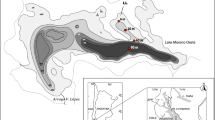Abstract
Water level fluctuations affect the size of the pelagic zone relative to the size of littoral habitats, and thus may influence the relative abundance of remains from planktonic and littoral cladocerans in sediment. The application of this planktonic/littoral ratio for the reconstruction of past water level changes is discussed using examples of: (1) surficial profundal sediments from lakes of different water depths; (2) Holocene variation in a profundal sediment core; (3) horizontal variation in surficial sediments within a lake; and (4) long term variation in an inshore sediment core. The latter seemed to be the most promising application of this ratio. Maximum effects of water depth changes on the lake fauna are expected in the littoral zone. It is, however, difficult to read this effect directly from subfossil cladoceran and chironomid assemblages from inshore sediments as shown by a sediment profile from a site exposed to a long term decrease of water depth.
Similar content being viewed by others
References
Alhonen, P., 1970. On the significance of the planktonic/littoral ratio in the cladoceran stratigraphy of lake sediments. Comm. Biol. 35: 1–9.
Brundin, L., 1956. Die bodenfaunistischen Seetypen und ihre Anwendung auf die Südhalbkugel. Rep. Inst. Freshw. Res. Drottningholm 37: 186–235.
Deevey, E. S., 1955. The obliteration of the hypolimnion. Mem. Ist. ital. Idrobiol. 8: 9–38.
Digerfeldt, G., 1986. Studies on past lakelevel changes. In Berglund, B. E. (ed.), Handbook of Holocene Palaeoecology and Palaeohydrology. Wiley & Sons, Chichester: 127–143.
Digerfeldt, G., 1988. Reconstruction and regional correlation of Holocene lake-level fluctuations in Lake Bysjöon, south Sweden. Boreas 17: 165–182.
Flöoßner, D., 1972. Kiemen-und Blattfüußer, Branchiopoda, Fischl äause, Branchiura. Die Tierwelt Deutschlands 60: 1499.
Frey, D. G., 1988. Littoral and offshore communities of diatoms, cladocerans and dipterous larvae, and their interpretation in paleolimnology. J. Paleolimnol. 1: 179–191.
Goulden, C. E., 1964. The history of the cladoceran fauna of Esth-waite Water (England) and its limnological significance. Arch. Hydrobiol. 60: 1–52.
Gripp, K., 1953. Die Entstehung der ostholsteinischen Seen und ihrer Entwäasserung. Schr. geogr. Inst. Univ. Kiel, Schmieder-Festband, 11–26.
Hofmann, W., 1986. Developmental history of the Großer Plöoner See and the Schöohsee (north Germany): cladoceran analysis, with special reference to eutrophication. Arch. Hydrobiol. Suppl. 74: 259–287.
Hofmann, W., 1993. Dynamics of a littoral Cladocera assemblage under the influence of climatic and water depth changes. Verh. int. Ver. Limnol. 25: 1095–1101.
Hofmann, W., 1996. Empirical relationships between cladoceran fauna and trophic state in thirteen northern German lakes: analysis of surficial sediments. Hydrobiologia 318: 195–201.
Lundbeck, J., 1926. Die Bodentierwelt norddeuscher Seen. Arch. Hydrobiol. 7: 1–143.
Mikulski, J. S., 1978. Value of some biological indices in case histories of lakes. Verh. int. Ver. Limnol. 20: 992–996.
Mueller, W. P., 1964. The distribution of cladoceran remains in surficial sediments from three northern Indiana lakes. Invest. Indiana Lakes & Streams 6: 1–63.
Overbeck, J. & R. J. Chrost (ed.), 1993. Microbial ecology of Lake Plußsee.Springer, New York, 392 pp.
Scheffer, M., S. H. Hosper, M. L. Meijer, B. Moss & E. Jeppesen, 1993. Alternative equilibria in shallow lakes. Trends in Ecology & Evolution 8: 275–279.
Schernewski, G., 1992. Raumzeitliche Prozesse und Strukturen im Wasserköorper des Belauer Sees. EcoSys 1: 1–160.
Schleuter, A., 1986. Die Chironomiden-Besiedlung stehender Kleingewäasser in Abhäangigkeit von Wasserfüuhrung und Fallaubeintrag. Arch. Hydrobiol. 105: 471–487.
Schwerdtfeger, F., 1975. Synöokologie. Parey, Hamburg, Berlin, 451 pp.
Sneath, H. A. & R. R. Sokal, 1973. Numerical taxonomy. Chapman & Hall, San Francisco, 573 pp.
Whiteside, M. C. & M. R. Swindoll, 1988. Guidelines and limitations to cladoceran paleoecological interpretations. Palaeogeogr. Palaeoclim. Palaeoecol. 62: 405–412.
Author information
Authors and Affiliations
Rights and permissions
About this article
Cite this article
Hofmann, W. Cladocerans and chironomids as indicators of lake level changes in north temperate lakes. Journal of Paleolimnology 19, 55–62 (1998). https://doi.org/10.1023/A:1007999419765
Issue Date:
DOI: https://doi.org/10.1023/A:1007999419765




